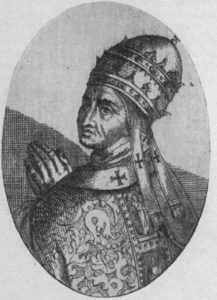1304
Death of a poisoned pope
At the beginning of the fourteenth century the Church’s greatest concern was its relationship to the secular powers, particularly the increasingly important national monarchies of western Europe. Most troublesome from a papal point of view were Philip IV (“the Fair”) of France and Edward I (“Longshanks”) of England. Both had tried to tax the Church in their lands and both had run up against scoldings from Pope Boniface VIII who went so far as to threaten both with excommunication. In 1302 Boniface laid down the law to European rulers in no uncertain terms; his bull Unam Sanctam declared that kings should kiss the feet of the pope who was the agent of God on Earth — he who resisted the pope resisted God. Philip replied by sent a raiding force to Italy under the command of Guillaume de Nogaret who had orders to kidnap Boniface and bring him back to France for trial. The expedition captured and roughed up the pope but Boniface was rescued by angry locals. Boniface died shortly thereafter, out of shame and anger it was said.
At a conclave in Rome in October 1303, Italian cardinal Nicola Boccasini was elected pope, taking the name of Benedict XI. A Dominican professor of theology and diplomat, Benedict was chosen largely because he was not seen as overtly hostile to the French. He proved this by rescinding Boniface’s bull Unam Sanctam but he proved obdurate in his dealings with de Nogaret, refusing to back down from a sentence of excommunication on the man who had dared lay his hands on his papal predecessor. After a short reign of eight months Benedict died suddenly and fingers were immediately pointed at de Nogaret who was accused of poisoning the pope. Certainly the French benefited from Benedict’s death. The next pope was a French puppet who cooperated in the move of the papacy from Rome to southern France, the so-called Babylonian Captivity of the Church.
